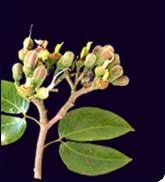Years ago, I read a lot of books on Tibet
and neighboring Buddhist countries such as Mustang, Sikkim,
and Bhutan. I believe it was a book about Mustang—but
it could have been any of the books I read at that time—that
described a custom of putting bits of cheese over the entrance
to home. When someone was ill, they scraped this area
and used the powder that fell in a tea. The author
might have regarded this custom as a silly superstition,
but actually, the local people had a way of producing natural
penicillin.

A quick summary
of the cheese making process may refresh our memories.
Cheese is obviously made from milk: milk from
cows, goats, sheep, or even yaks and buffalos. The
first step is to turn the milk to curds. Then, the
whey is removed by pressing. Next, the cheese is aged
by bacterial and fungal action.
Blue
Cheese
While
Roquefort is highly regarded by some, it disgusts me and
makes others sick. If you are a fan of
blue cheeses, then you probably appreciate that these cheeses
are less fibrous. This
is because the mold has decomposed, okay broken down, the
more complex molecules . . . and imparted the characteristic
sharp taste to this cheese. That taste is due to the
fungal metabolites, butyric acid, something with a commercial
application as a disinfectant. If the same odor were
found in butter as in blue cheese, you would throw away the
butter because it is rancid.
 The
truth is, if you knew how Roquefort cheese is made, or rather
how it used to be made, you would probably never eat it again! Or
maybe, you are not bothered by aesthetics and you can by-pass
your instincts and appreciate the science? Either way,
we are talking here about mold. What
gives Roquefort its marbled look is mold, to be specific, Penicillium
roqueforti.
The
truth is, if you knew how Roquefort cheese is made, or rather
how it used to be made, you would probably never eat it again! Or
maybe, you are not bothered by aesthetics and you can by-pass
your instincts and appreciate the science? Either way,
we are talking here about mold. What
gives Roquefort its marbled look is mold, to be specific, Penicillium
roqueforti.
Brie
Brie is another cheese with
mold. I vividly remember a quiet dinner with the Swiss
doctor with whom I stayed on my last trip to Europe. She
served a number of different cheeses and ate the rind of
the Brie and then watched with a thinly veiled, ergo polite,
look of astonishment as I cut away the moldy outer crust. Brie
also has a type of penicillium as a starter: Penicillium
candidum.
This skin is formed by molds
on the surface of the cheese that begin with very thin, hairy
white strands. The French call this poil
de chat: cat's
fur. The furry part is rubbed off and what remains
is regarded as edible by those who consider it a delicacy. Like
Charlemagne's first encounter with this cheese, I prefer
the soft inside (but Charlemagne, as the story goes, was
won over and came to regard the fur as something very special.)
Cheese Molds
I suppose there would be propagandists
in the cheese industry who view Roquefort as possessed by
a useful mold, i.e. penicillium,
a mold that loves dark caves and stones (and basements and
garages.) You could study
how these blue cheeses are made, but I will save you a little
research and go straight to the bottom line. Each new
batch of cheese requires the use of some of the previous
batch (unless using a commercial starter). To activate
the new batch, you need only dip a skewer in the old and
pierce the new.
Next time, you are peeling
fruit or cutting away some mold, think about this and be
really careful what your knife has touched! You could make someone
very sick with just one careless motion.
Keep in mind that spores
have long feeding tubes called hyphae that
can penetrate well beyond the visible surface of the mold
colony. It
would be really easy to stray way off topic, but when there
are many strands of hyphae bundled together, the ganglion
is called a mycelium. It can become a large mass and
completely occupy a space, its meal. The hyphae composing
the mycelium can be very fast growing, some adding one kilometer
to the mycelium each day.
Ingrid
Naiman
15 November 2005
Updated:
9 October 2010

Recommended link: http://www.uoguelph.ca/~gbarron/MISCELLANEOUS/penicill.htm




Sacred
Medicine Sanctuary
Copyright by Ingrid Naiman
2005
No part of this site
may be reproduced or published in any form or on any
other web site without written
permission from the site owner.



 The
truth is, if you knew how Roquefort cheese is made, or rather
how it used to be made, you would probably never eat it again! Or
maybe, you are not bothered by aesthetics and you can by-pass
your instincts and appreciate the science? Either way,
we are talking here about mold. What
gives Roquefort its marbled look is mold, to be specific, Penicillium
roqueforti.
The
truth is, if you knew how Roquefort cheese is made, or rather
how it used to be made, you would probably never eat it again! Or
maybe, you are not bothered by aesthetics and you can by-pass
your instincts and appreciate the science? Either way,
we are talking here about mold. What
gives Roquefort its marbled look is mold, to be specific, Penicillium
roqueforti. 
